Child Observation Report: Analysis of Child Development and Assessment
VerifiedAdded on 2022/09/05
|7
|1556
|17
Report
AI Summary
This report provides a detailed analysis of child observation as an assessment tool within the context of the Australian Early Childhood Educational Framework, specifically focusing on the 'Belonging, Being, and Becoming' model. It examines how child observation techniques are used to assess children's individual styles, behaviors, and learning progress. The report explores the appropriateness of child observation as an assessment method, including the use of learning stories and summative assessment, particularly for infants, toddlers, and preschoolers. It also addresses the ethical implications of using such tools, emphasizing the importance of constructive feedback, professional conduct, and communication with families. The report connects the framework to developmental, socio-cultural, and critical theories, highlighting how these theories influence child development practices. It concludes by emphasizing the value of child observation in gaining insights into children's cognitive, emotional, behavioral, and social development.
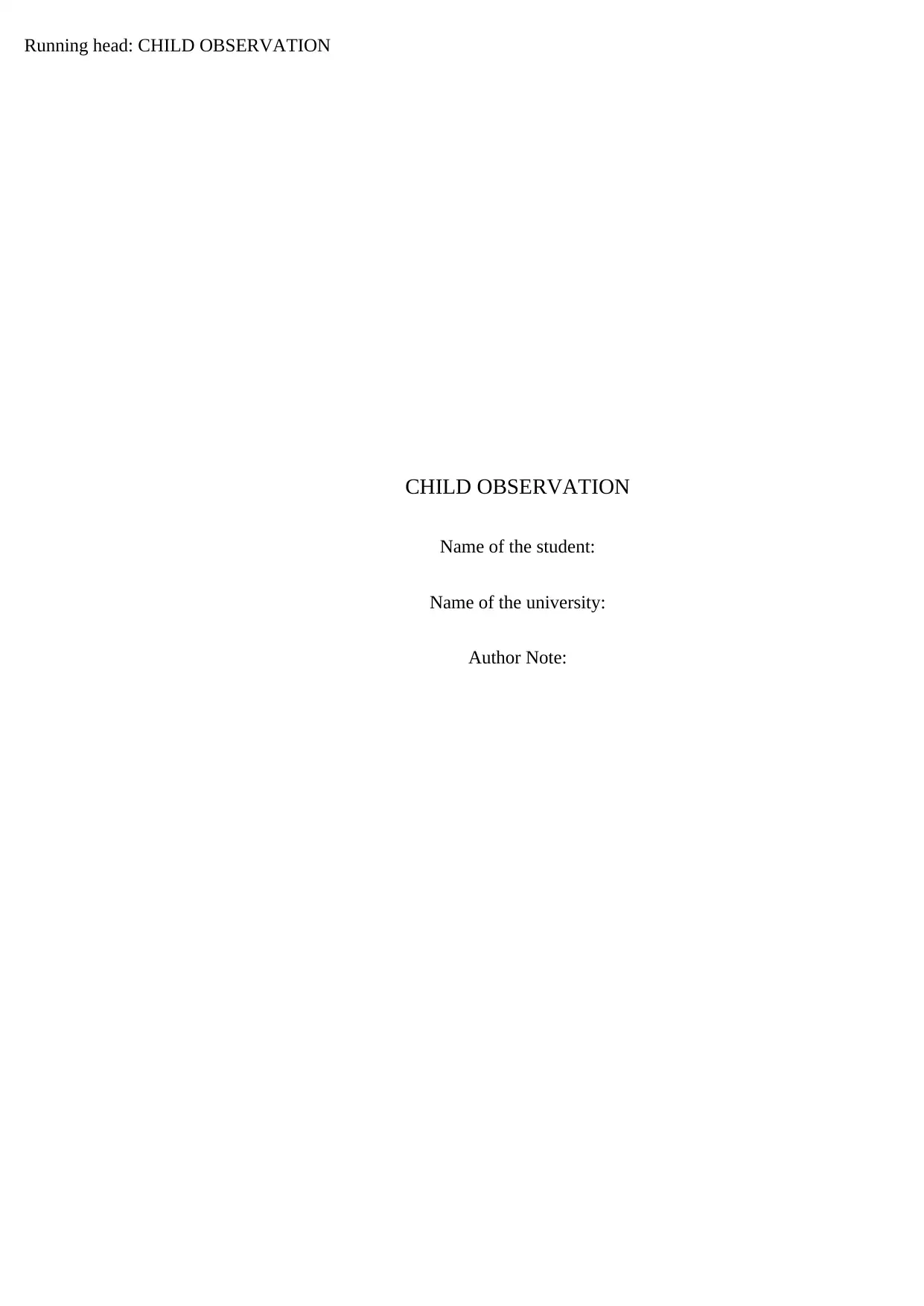
Running head: CHILD OBSERVATION
CHILD OBSERVATION
Name of the student:
Name of the university:
Author Note:
CHILD OBSERVATION
Name of the student:
Name of the university:
Author Note:
Paraphrase This Document
Need a fresh take? Get an instant paraphrase of this document with our AI Paraphraser
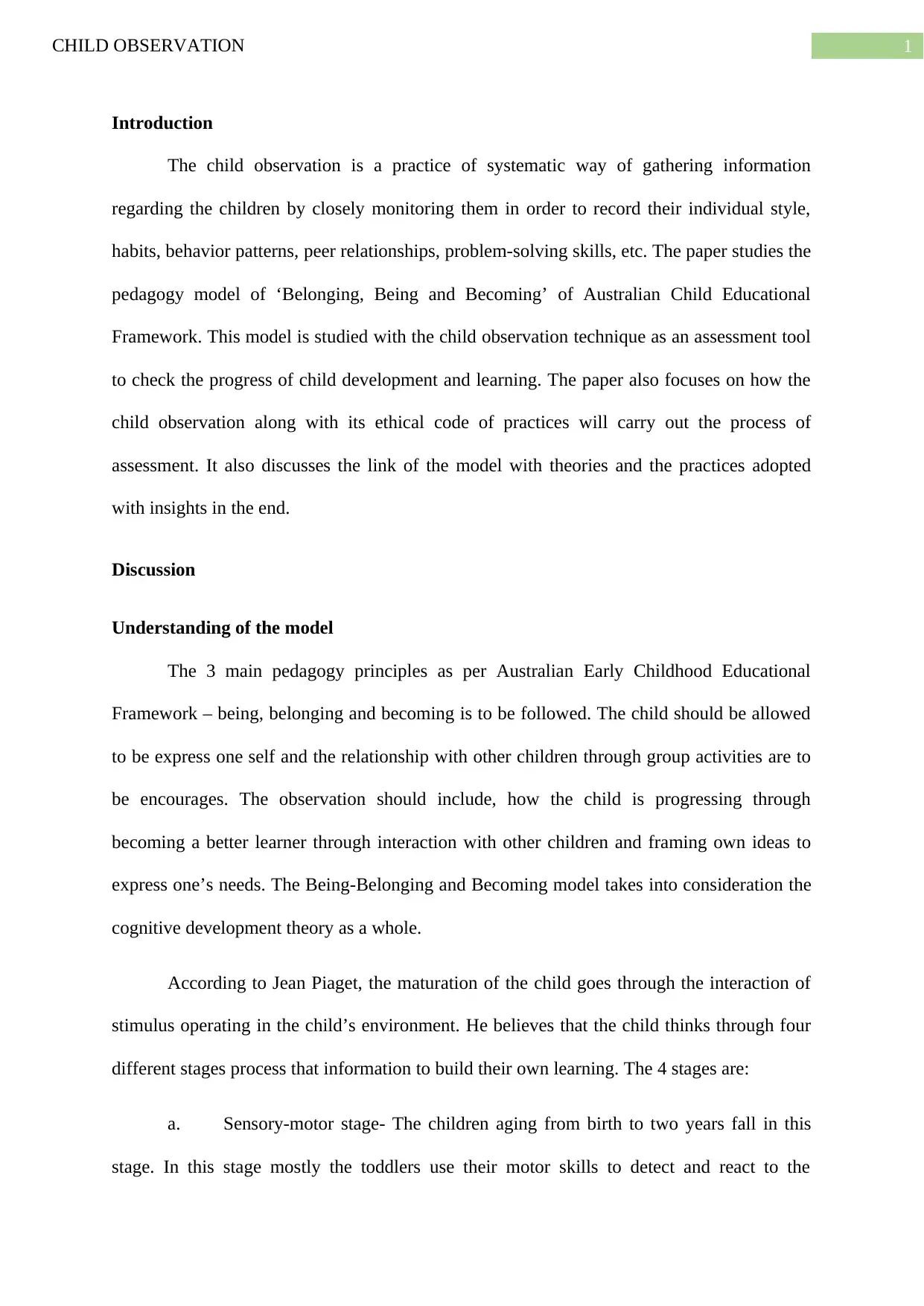
1CHILD OBSERVATION
Introduction
The child observation is a practice of systematic way of gathering information
regarding the children by closely monitoring them in order to record their individual style,
habits, behavior patterns, peer relationships, problem-solving skills, etc. The paper studies the
pedagogy model of ‘Belonging, Being and Becoming’ of Australian Child Educational
Framework. This model is studied with the child observation technique as an assessment tool
to check the progress of child development and learning. The paper also focuses on how the
child observation along with its ethical code of practices will carry out the process of
assessment. It also discusses the link of the model with theories and the practices adopted
with insights in the end.
Discussion
Understanding of the model
The 3 main pedagogy principles as per Australian Early Childhood Educational
Framework – being, belonging and becoming is to be followed. The child should be allowed
to be express one self and the relationship with other children through group activities are to
be encourages. The observation should include, how the child is progressing through
becoming a better learner through interaction with other children and framing own ideas to
express one’s needs. The Being-Belonging and Becoming model takes into consideration the
cognitive development theory as a whole.
According to Jean Piaget, the maturation of the child goes through the interaction of
stimulus operating in the child’s environment. He believes that the child thinks through four
different stages process that information to build their own learning. The 4 stages are:
a. Sensory-motor stage- The children aging from birth to two years fall in this
stage. In this stage mostly the toddlers use their motor skills to detect and react to the
Introduction
The child observation is a practice of systematic way of gathering information
regarding the children by closely monitoring them in order to record their individual style,
habits, behavior patterns, peer relationships, problem-solving skills, etc. The paper studies the
pedagogy model of ‘Belonging, Being and Becoming’ of Australian Child Educational
Framework. This model is studied with the child observation technique as an assessment tool
to check the progress of child development and learning. The paper also focuses on how the
child observation along with its ethical code of practices will carry out the process of
assessment. It also discusses the link of the model with theories and the practices adopted
with insights in the end.
Discussion
Understanding of the model
The 3 main pedagogy principles as per Australian Early Childhood Educational
Framework – being, belonging and becoming is to be followed. The child should be allowed
to be express one self and the relationship with other children through group activities are to
be encourages. The observation should include, how the child is progressing through
becoming a better learner through interaction with other children and framing own ideas to
express one’s needs. The Being-Belonging and Becoming model takes into consideration the
cognitive development theory as a whole.
According to Jean Piaget, the maturation of the child goes through the interaction of
stimulus operating in the child’s environment. He believes that the child thinks through four
different stages process that information to build their own learning. The 4 stages are:
a. Sensory-motor stage- The children aging from birth to two years fall in this
stage. In this stage mostly the toddlers use their motor skills to detect and react to the
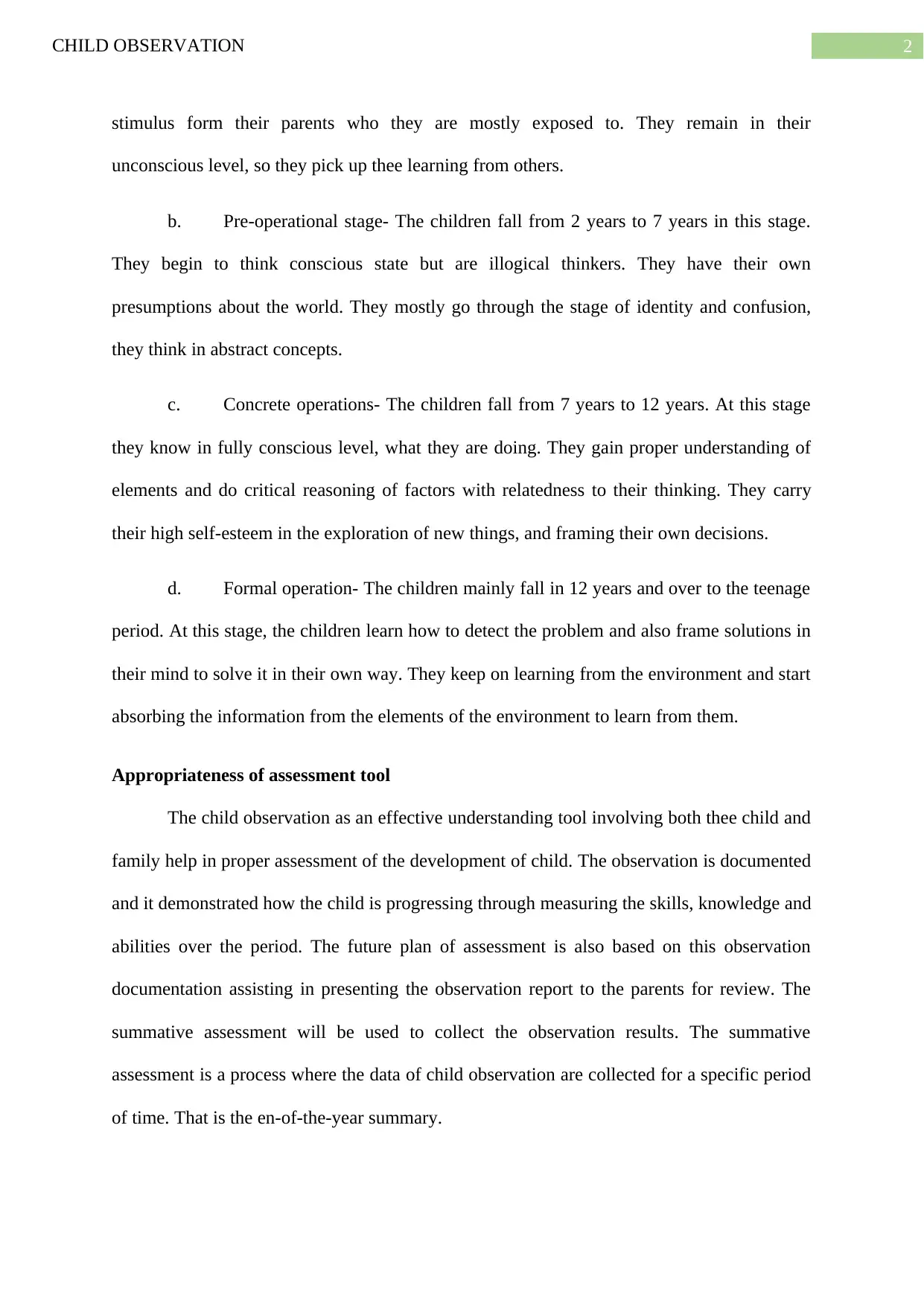
2CHILD OBSERVATION
stimulus form their parents who they are mostly exposed to. They remain in their
unconscious level, so they pick up thee learning from others.
b. Pre-operational stage- The children fall from 2 years to 7 years in this stage.
They begin to think conscious state but are illogical thinkers. They have their own
presumptions about the world. They mostly go through the stage of identity and confusion,
they think in abstract concepts.
c. Concrete operations- The children fall from 7 years to 12 years. At this stage
they know in fully conscious level, what they are doing. They gain proper understanding of
elements and do critical reasoning of factors with relatedness to their thinking. They carry
their high self-esteem in the exploration of new things, and framing their own decisions.
d. Formal operation- The children mainly fall in 12 years and over to the teenage
period. At this stage, the children learn how to detect the problem and also frame solutions in
their mind to solve it in their own way. They keep on learning from the environment and start
absorbing the information from the elements of the environment to learn from them.
Appropriateness of assessment tool
The child observation as an effective understanding tool involving both thee child and
family help in proper assessment of the development of child. The observation is documented
and it demonstrated how the child is progressing through measuring the skills, knowledge and
abilities over the period. The future plan of assessment is also based on this observation
documentation assisting in presenting the observation report to the parents for review. The
summative assessment will be used to collect the observation results. The summative
assessment is a process where the data of child observation are collected for a specific period
of time. That is the en-of-the-year summary.
stimulus form their parents who they are mostly exposed to. They remain in their
unconscious level, so they pick up thee learning from others.
b. Pre-operational stage- The children fall from 2 years to 7 years in this stage.
They begin to think conscious state but are illogical thinkers. They have their own
presumptions about the world. They mostly go through the stage of identity and confusion,
they think in abstract concepts.
c. Concrete operations- The children fall from 7 years to 12 years. At this stage
they know in fully conscious level, what they are doing. They gain proper understanding of
elements and do critical reasoning of factors with relatedness to their thinking. They carry
their high self-esteem in the exploration of new things, and framing their own decisions.
d. Formal operation- The children mainly fall in 12 years and over to the teenage
period. At this stage, the children learn how to detect the problem and also frame solutions in
their mind to solve it in their own way. They keep on learning from the environment and start
absorbing the information from the elements of the environment to learn from them.
Appropriateness of assessment tool
The child observation as an effective understanding tool involving both thee child and
family help in proper assessment of the development of child. The observation is documented
and it demonstrated how the child is progressing through measuring the skills, knowledge and
abilities over the period. The future plan of assessment is also based on this observation
documentation assisting in presenting the observation report to the parents for review. The
summative assessment will be used to collect the observation results. The summative
assessment is a process where the data of child observation are collected for a specific period
of time. That is the en-of-the-year summary.
⊘ This is a preview!⊘
Do you want full access?
Subscribe today to unlock all pages.

Trusted by 1+ million students worldwide
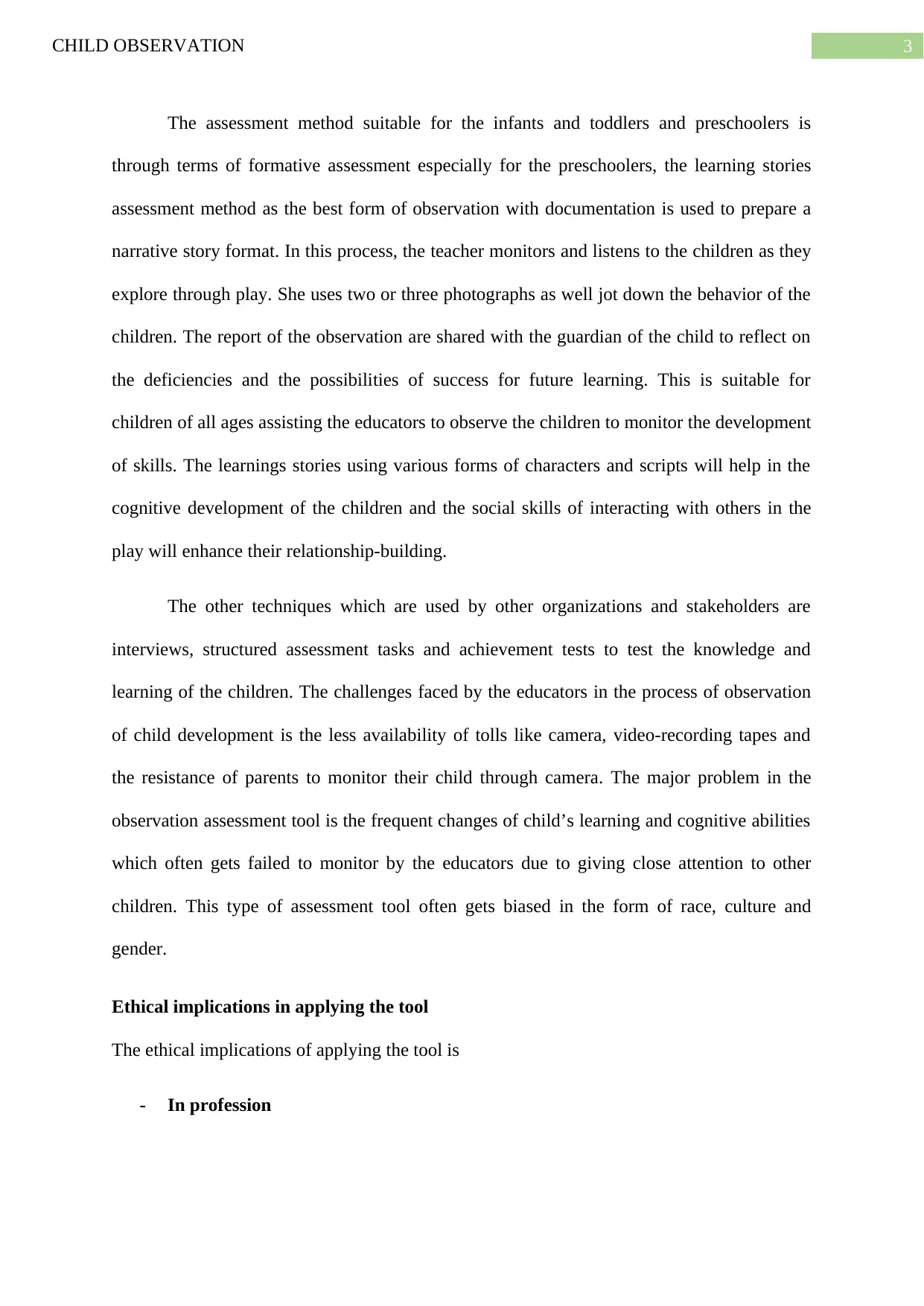
3CHILD OBSERVATION
The assessment method suitable for the infants and toddlers and preschoolers is
through terms of formative assessment especially for the preschoolers, the learning stories
assessment method as the best form of observation with documentation is used to prepare a
narrative story format. In this process, the teacher monitors and listens to the children as they
explore through play. She uses two or three photographs as well jot down the behavior of the
children. The report of the observation are shared with the guardian of the child to reflect on
the deficiencies and the possibilities of success for future learning. This is suitable for
children of all ages assisting the educators to observe the children to monitor the development
of skills. The learnings stories using various forms of characters and scripts will help in the
cognitive development of the children and the social skills of interacting with others in the
play will enhance their relationship-building.
The other techniques which are used by other organizations and stakeholders are
interviews, structured assessment tasks and achievement tests to test the knowledge and
learning of the children. The challenges faced by the educators in the process of observation
of child development is the less availability of tolls like camera, video-recording tapes and
the resistance of parents to monitor their child through camera. The major problem in the
observation assessment tool is the frequent changes of child’s learning and cognitive abilities
which often gets failed to monitor by the educators due to giving close attention to other
children. This type of assessment tool often gets biased in the form of race, culture and
gender.
Ethical implications in applying the tool
The ethical implications of applying the tool is
- In profession
The assessment method suitable for the infants and toddlers and preschoolers is
through terms of formative assessment especially for the preschoolers, the learning stories
assessment method as the best form of observation with documentation is used to prepare a
narrative story format. In this process, the teacher monitors and listens to the children as they
explore through play. She uses two or three photographs as well jot down the behavior of the
children. The report of the observation are shared with the guardian of the child to reflect on
the deficiencies and the possibilities of success for future learning. This is suitable for
children of all ages assisting the educators to observe the children to monitor the development
of skills. The learnings stories using various forms of characters and scripts will help in the
cognitive development of the children and the social skills of interacting with others in the
play will enhance their relationship-building.
The other techniques which are used by other organizations and stakeholders are
interviews, structured assessment tasks and achievement tests to test the knowledge and
learning of the children. The challenges faced by the educators in the process of observation
of child development is the less availability of tolls like camera, video-recording tapes and
the resistance of parents to monitor their child through camera. The major problem in the
observation assessment tool is the frequent changes of child’s learning and cognitive abilities
which often gets failed to monitor by the educators due to giving close attention to other
children. This type of assessment tool often gets biased in the form of race, culture and
gender.
Ethical implications in applying the tool
The ethical implications of applying the tool is
- In profession
Paraphrase This Document
Need a fresh take? Get an instant paraphrase of this document with our AI Paraphraser
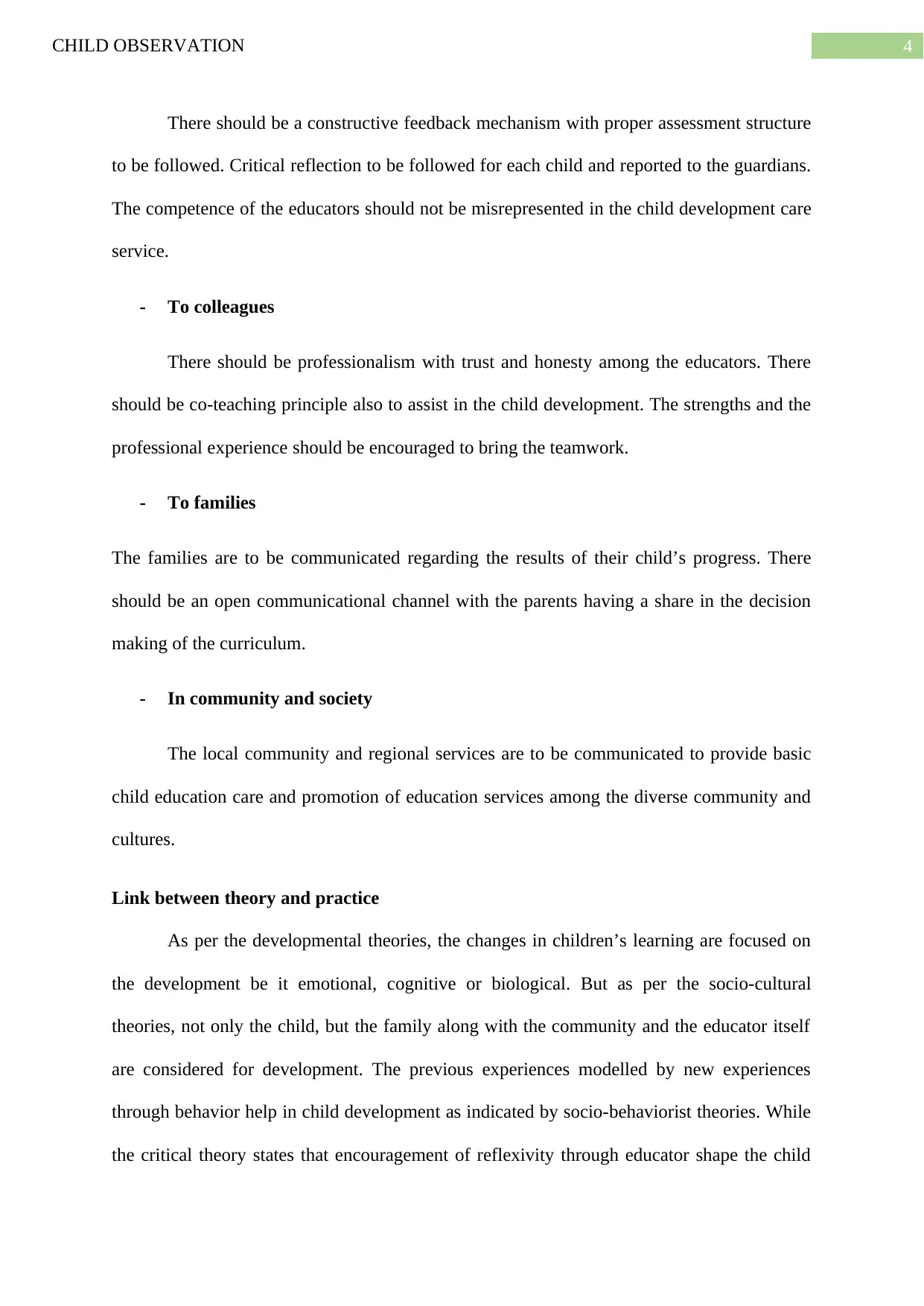
4CHILD OBSERVATION
There should be a constructive feedback mechanism with proper assessment structure
to be followed. Critical reflection to be followed for each child and reported to the guardians.
The competence of the educators should not be misrepresented in the child development care
service.
- To colleagues
There should be professionalism with trust and honesty among the educators. There
should be co-teaching principle also to assist in the child development. The strengths and the
professional experience should be encouraged to bring the teamwork.
- To families
The families are to be communicated regarding the results of their child’s progress. There
should be an open communicational channel with the parents having a share in the decision
making of the curriculum.
- In community and society
The local community and regional services are to be communicated to provide basic
child education care and promotion of education services among the diverse community and
cultures.
Link between theory and practice
As per the developmental theories, the changes in children’s learning are focused on
the development be it emotional, cognitive or biological. But as per the socio-cultural
theories, not only the child, but the family along with the community and the educator itself
are considered for development. The previous experiences modelled by new experiences
through behavior help in child development as indicated by socio-behaviorist theories. While
the critical theory states that encouragement of reflexivity through educator shape the child
There should be a constructive feedback mechanism with proper assessment structure
to be followed. Critical reflection to be followed for each child and reported to the guardians.
The competence of the educators should not be misrepresented in the child development care
service.
- To colleagues
There should be professionalism with trust and honesty among the educators. There
should be co-teaching principle also to assist in the child development. The strengths and the
professional experience should be encouraged to bring the teamwork.
- To families
The families are to be communicated regarding the results of their child’s progress. There
should be an open communicational channel with the parents having a share in the decision
making of the curriculum.
- In community and society
The local community and regional services are to be communicated to provide basic
child education care and promotion of education services among the diverse community and
cultures.
Link between theory and practice
As per the developmental theories, the changes in children’s learning are focused on
the development be it emotional, cognitive or biological. But as per the socio-cultural
theories, not only the child, but the family along with the community and the educator itself
are considered for development. The previous experiences modelled by new experiences
through behavior help in child development as indicated by socio-behaviorist theories. While
the critical theory states that encouragement of reflexivity through educator shape the child
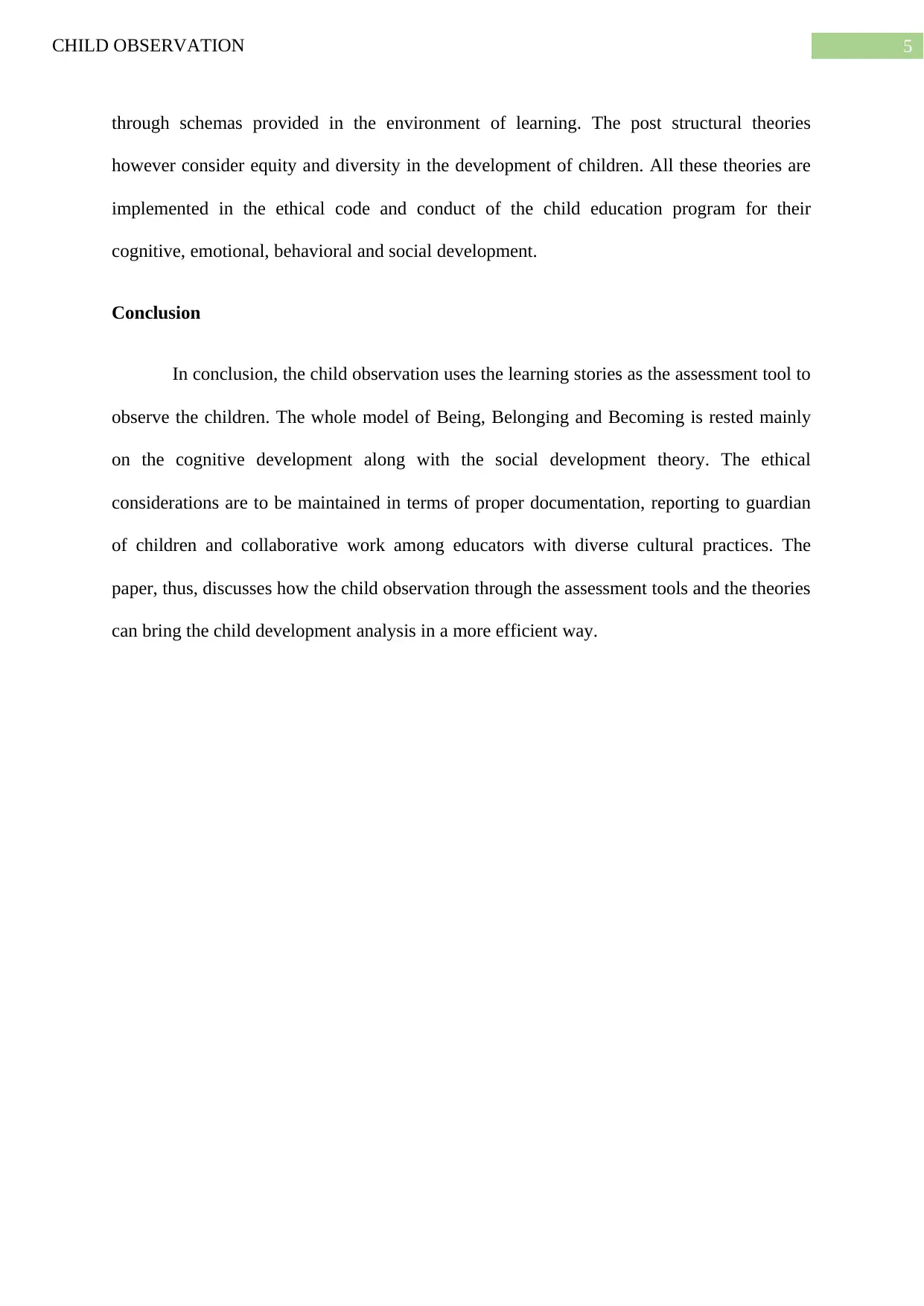
5CHILD OBSERVATION
through schemas provided in the environment of learning. The post structural theories
however consider equity and diversity in the development of children. All these theories are
implemented in the ethical code and conduct of the child education program for their
cognitive, emotional, behavioral and social development.
Conclusion
In conclusion, the child observation uses the learning stories as the assessment tool to
observe the children. The whole model of Being, Belonging and Becoming is rested mainly
on the cognitive development along with the social development theory. The ethical
considerations are to be maintained in terms of proper documentation, reporting to guardian
of children and collaborative work among educators with diverse cultural practices. The
paper, thus, discusses how the child observation through the assessment tools and the theories
can bring the child development analysis in a more efficient way.
through schemas provided in the environment of learning. The post structural theories
however consider equity and diversity in the development of children. All these theories are
implemented in the ethical code and conduct of the child education program for their
cognitive, emotional, behavioral and social development.
Conclusion
In conclusion, the child observation uses the learning stories as the assessment tool to
observe the children. The whole model of Being, Belonging and Becoming is rested mainly
on the cognitive development along with the social development theory. The ethical
considerations are to be maintained in terms of proper documentation, reporting to guardian
of children and collaborative work among educators with diverse cultural practices. The
paper, thus, discusses how the child observation through the assessment tools and the theories
can bring the child development analysis in a more efficient way.
⊘ This is a preview!⊘
Do you want full access?
Subscribe today to unlock all pages.

Trusted by 1+ million students worldwide
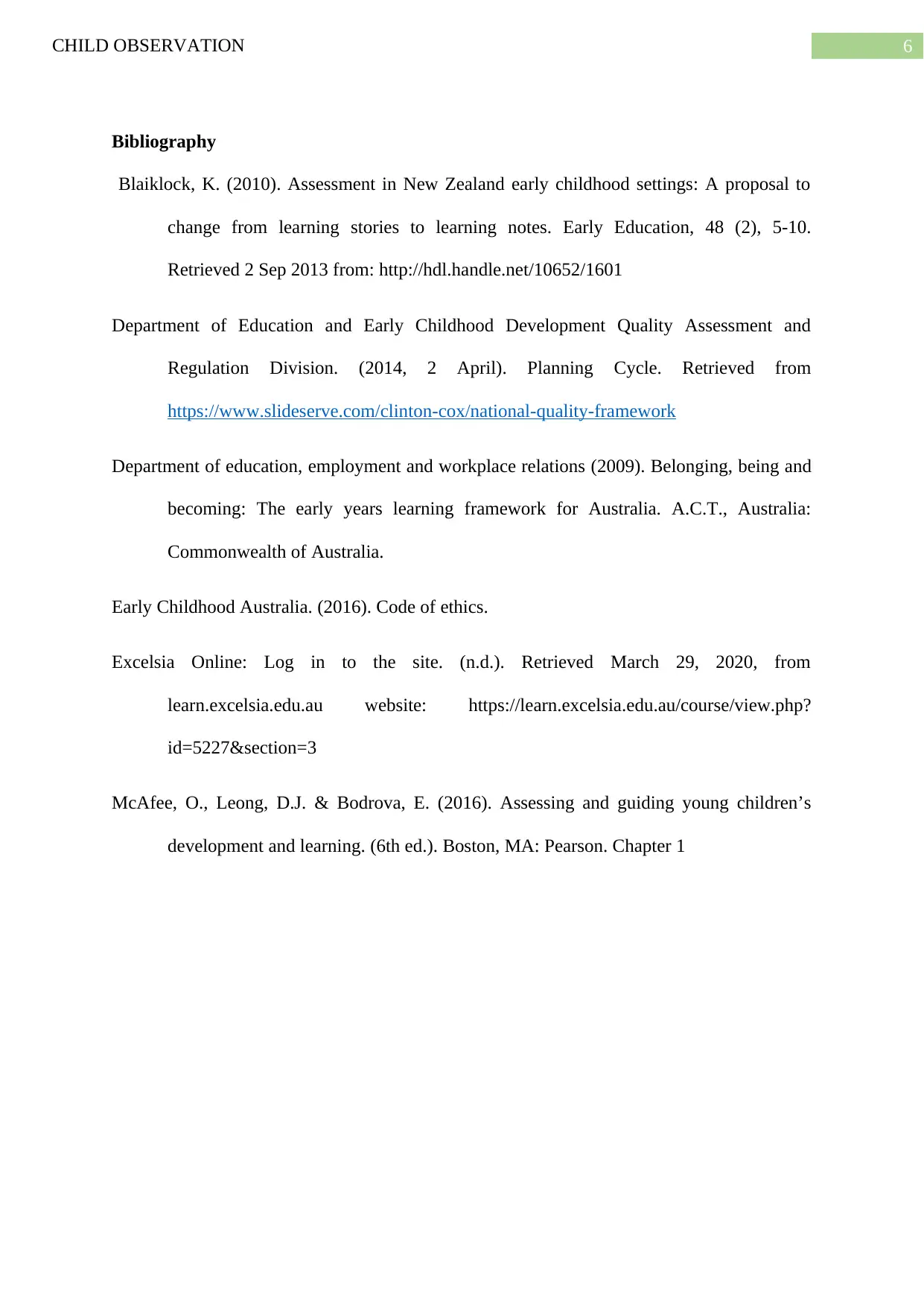
6CHILD OBSERVATION
Bibliography
Blaiklock, K. (2010). Assessment in New Zealand early childhood settings: A proposal to
change from learning stories to learning notes. Early Education, 48 (2), 5-10.
Retrieved 2 Sep 2013 from: http://hdl.handle.net/10652/1601
Department of Education and Early Childhood Development Quality Assessment and
Regulation Division. (2014, 2 April). Planning Cycle. Retrieved from
https://www.slideserve.com/clinton-cox/national-quality-framework
Department of education, employment and workplace relations (2009). Belonging, being and
becoming: The early years learning framework for Australia. A.C.T., Australia:
Commonwealth of Australia.
Early Childhood Australia. (2016). Code of ethics.
Excelsia Online: Log in to the site. (n.d.). Retrieved March 29, 2020, from
learn.excelsia.edu.au website: https://learn.excelsia.edu.au/course/view.php?
id=5227§ion=3
McAfee, O., Leong, D.J. & Bodrova, E. (2016). Assessing and guiding young children’s
development and learning. (6th ed.). Boston, MA: Pearson. Chapter 1
Bibliography
Blaiklock, K. (2010). Assessment in New Zealand early childhood settings: A proposal to
change from learning stories to learning notes. Early Education, 48 (2), 5-10.
Retrieved 2 Sep 2013 from: http://hdl.handle.net/10652/1601
Department of Education and Early Childhood Development Quality Assessment and
Regulation Division. (2014, 2 April). Planning Cycle. Retrieved from
https://www.slideserve.com/clinton-cox/national-quality-framework
Department of education, employment and workplace relations (2009). Belonging, being and
becoming: The early years learning framework for Australia. A.C.T., Australia:
Commonwealth of Australia.
Early Childhood Australia. (2016). Code of ethics.
Excelsia Online: Log in to the site. (n.d.). Retrieved March 29, 2020, from
learn.excelsia.edu.au website: https://learn.excelsia.edu.au/course/view.php?
id=5227§ion=3
McAfee, O., Leong, D.J. & Bodrova, E. (2016). Assessing and guiding young children’s
development and learning. (6th ed.). Boston, MA: Pearson. Chapter 1
1 out of 7
Related Documents
Your All-in-One AI-Powered Toolkit for Academic Success.
+13062052269
info@desklib.com
Available 24*7 on WhatsApp / Email
![[object Object]](/_next/static/media/star-bottom.7253800d.svg)
Unlock your academic potential
Copyright © 2020–2025 A2Z Services. All Rights Reserved. Developed and managed by ZUCOL.




